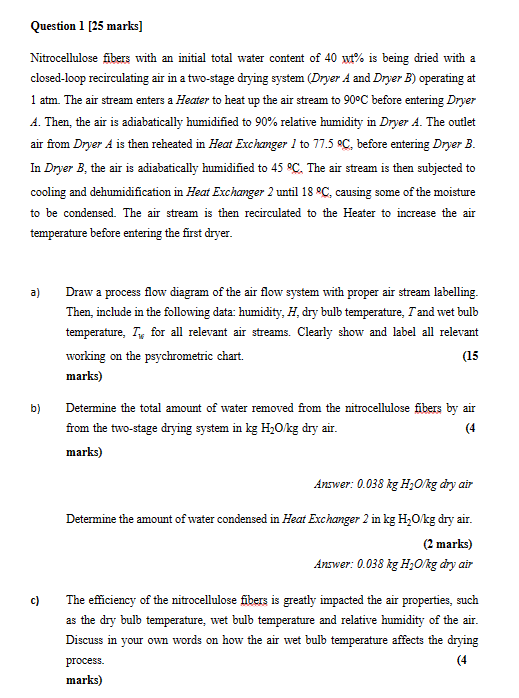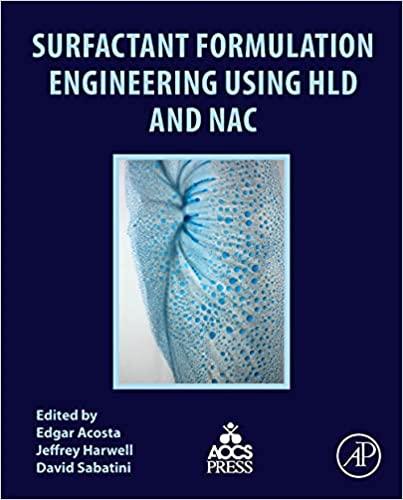Please help answer all questions

Question 1 [25 marks] Nitrocellulose fibers with an initial total water content of 40xt% is being dried with a closed-loop recirculating air in a two-stage drying system (Dryer A and Dryer B) operating at 1atm. The air stream enters a Heater to heat up the air stream to 90C before entering Dryer A. Then, the air is adiabatically humidified to 90% relative humidity in Dryer A. The outlet air from Dryer A is then reheated in Heat Exchanger 1 to 77.5C, before entering Dryer B. In Dryer B, the air is adiabatically humidified to 45C. The air stream is then subjected to cooling and dehumidification in Heat Exchanger 2 until 18C, causing some of the moisture to be condensed. The air stream is then recirculated to the Heater to increase the air temperature before entering the first dryer. a) Draw a process flow diagram of the air flow system with proper air stream labelling. Then, include in the following data: humidity, H, dry bulb temperature, T and wet bulb temperature, Tv for all relevant air streams. Clearly show and label all relevant working on the psychrometric chart. (15 marks) b) Determine the total amount of water removed from the nitrocellulose fibers by air from the two-stage drying system in kgH2O/kg dry air. (4 marks) Answer: 0.038kgH2O/kg dry air Determine the amount of water condensed in Heat Exchanger 2 in kgH2O/kg dry air. ( 2 marks) Answer: 0.038kgH2O/kg dry air c) The efficiency of the nitrocellulose fibers is greatly impacted the air properties, such as the dry bulb temperature, wet bulb temperature and relative humidity of the air. Discuss in your own words on how the air wet bulb temperature affects the drying process. (4) marks) Question 1 [25 marks] Nitrocellulose fibers with an initial total water content of 40xt% is being dried with a closed-loop recirculating air in a two-stage drying system (Dryer A and Dryer B) operating at 1atm. The air stream enters a Heater to heat up the air stream to 90C before entering Dryer A. Then, the air is adiabatically humidified to 90% relative humidity in Dryer A. The outlet air from Dryer A is then reheated in Heat Exchanger 1 to 77.5C, before entering Dryer B. In Dryer B, the air is adiabatically humidified to 45C. The air stream is then subjected to cooling and dehumidification in Heat Exchanger 2 until 18C, causing some of the moisture to be condensed. The air stream is then recirculated to the Heater to increase the air temperature before entering the first dryer. a) Draw a process flow diagram of the air flow system with proper air stream labelling. Then, include in the following data: humidity, H, dry bulb temperature, T and wet bulb temperature, Tv for all relevant air streams. Clearly show and label all relevant working on the psychrometric chart. (15 marks) b) Determine the total amount of water removed from the nitrocellulose fibers by air from the two-stage drying system in kgH2O/kg dry air. (4 marks) Answer: 0.038kgH2O/kg dry air Determine the amount of water condensed in Heat Exchanger 2 in kgH2O/kg dry air. ( 2 marks) Answer: 0.038kgH2O/kg dry air c) The efficiency of the nitrocellulose fibers is greatly impacted the air properties, such as the dry bulb temperature, wet bulb temperature and relative humidity of the air. Discuss in your own words on how the air wet bulb temperature affects the drying process. (4) marks)







